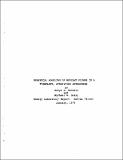| dc.contributor.author | Bennett, Ralph Gregory | |
| dc.contributor.author | Golay, Michael Warren | |
| dc.date.accessioned | 2006-06-05T17:35:09Z | |
| dc.date.available | 2006-06-05T17:35:09Z | |
| dc.date.issued | 1979-01 | |
| dc.identifier.other | 06348669 | |
| dc.identifier.uri | http://hdl.handle.net/1721.1/32996 | |
| dc.description.abstract | A widely applicable computational model of buoyant,
bent-over plumes in realistic atmospheres is constructed.
To do this, the two-dimensional, time-dependent fluid
mechanics equations are numerically integrated, while a
number of important physical approximations serve to keep
the approach at a tractable level. A three-dimensional
picture of a steady state plume is constructed from a se-
quence of time-dependent, two-dimensional plume cross sec-
tions--each cross section of the sequence is spaced pro-
gressively further downwind as it is advected for a pro-
gressively longer time by the prevailing wind. The dyna-
mics of the plume simulations are quite general. The
buoyancy sources in the plume include the sensible heat in
the plume, the latent heat absorbed or released in plume
moisture processes, and the heating of the plume by a
radioactive pollutant in the plume. The atmospheric state
in the simulations is also quite general. Atmospheric
variables are allowed to be functions of height, and the
ambient atmospheric turbulence (also a function of height)
is included in the simulations.
A demonstration of the ability of the model to repro-
duce the solutions to problems that are known is under-
taken. Comparisons to buoyant line-thermal laboratory
experiments show that the model calculates the dynamics of
the fluid motions to an acceptable accuracy. Comparisons
to atmospheric plume rise and dispersion experiments show
that the model can simulate individual plumes more accur-
ately than existing correlations because it calculates the
effect of the atmospheric turbulence and stratification
from first-principles. The comparisons also show that
improvements to the model are likely to be made by more
accurately describing the anisotropic nature of atmospheric
turbulence, and the production of turbulence by the sources
of buoyancy. | en |
| dc.description.sponsorship | Sponsored by the Consolidated Edison Company of New York and Northeast Utilities Service Corporation. | en |
| dc.format.extent | 10743689 bytes | |
| dc.format.mimetype | application/pdf | |
| dc.language.iso | en_US | en |
| dc.publisher | MIT Energy Laboratory | en |
| dc.relation.ispartofseries | MIT-EL | en |
| dc.relation.ispartofseries | 79-002 | en |
| dc.subject | Plumes (Fluid dynamics) |x Mathematical models. | en |
| dc.title | Numerical modeling of buoyant plumes in a turbulent, stratified atmosphere | en |
| dc.type | Technical Report | en |
